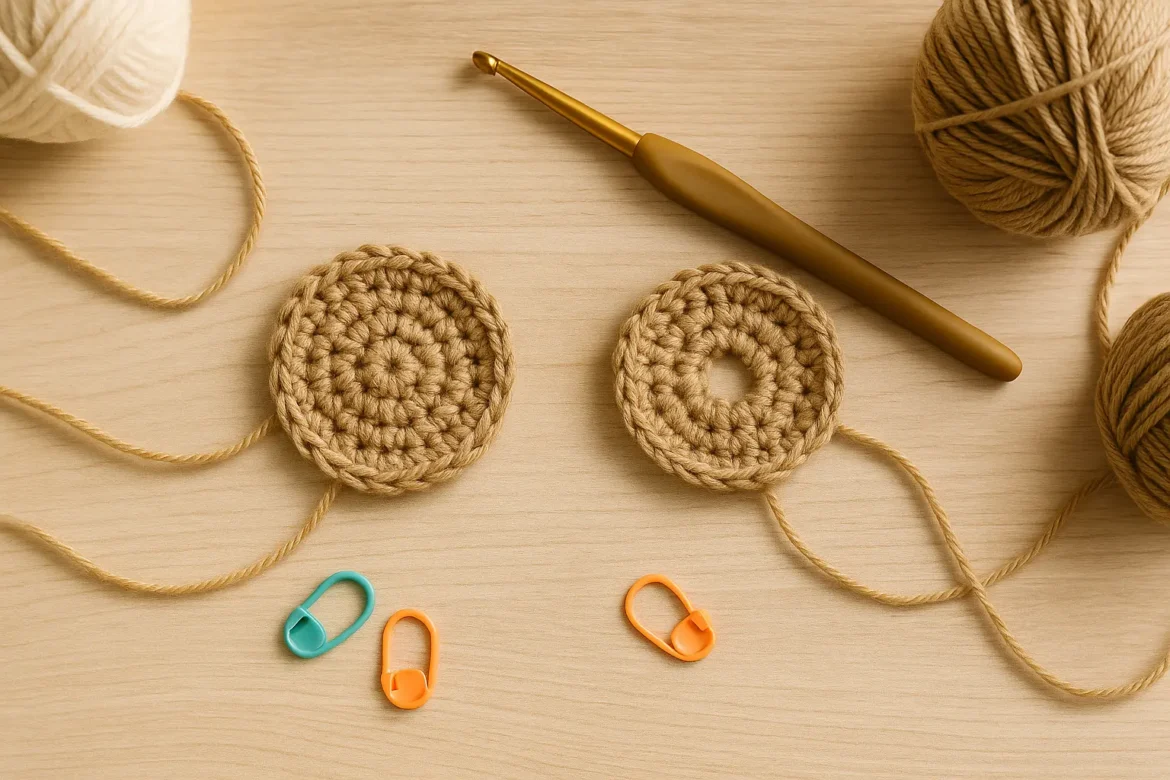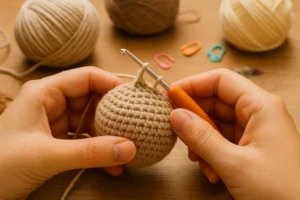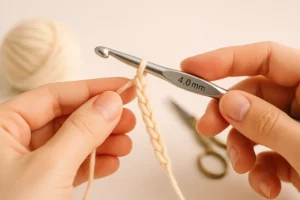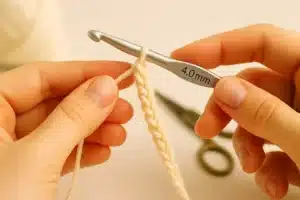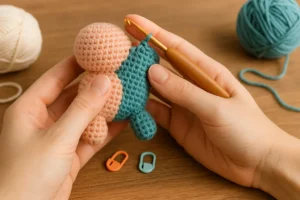Before I stitched my first little bunny, I had no idea there was a crochet debate hiding in plain sight. I just assumed there was one way to start a project, and then I stumbled into the discussion: magic ring vs chain circle. Two ways to begin a round. Two very different results.
If you’re just learning how to crochet amigurumi, you’ve likely seen both of these terms pop up in tutorials or pattern instructions. One says “6 sc in magic ring,” the other starts with “ch 2, 6 sc in second chain.” At first, it’s confusing, do they mean the same thing? Is one better? Will using the wrong one mess up your toy?
Let me tell you: I’ve asked myself those same questions. And over the years (and dozens of stuffed toys later), I’ve tested both methods in all sorts of projects, round heads, flat feet, spiky tails, you name it. The way you begin your round does matter, especially when it comes to how tight, neat, or wobbly your amigurumi turns out.
In this article, I’ll walk you through everything you need to know about the magic ring vs chain circle battle:
Table of Contents
By the end, you’ll not only understand how to start your next project, but you’ll also feel confident picking the method that’s best for the toy you’re making.
So grab your hook, a skein of yarn, and let’s settle the magic ring vs chain circle debate once and for all with real advice, not fluff.
My First Rings — A Personal Tale
The First Time I Tried Both
When I first dipped my hook into the world of amigurumi, I wasn’t chasing perfection, I just wanted to make a cute little creature for my granddaughter. I remember settling down with my yarn, full of enthusiasm, when I saw the first line of the pattern:
Rnd 1: 6 sc in magic ring.
Magic what?
I paused. Was this some fancy new stitch I hadn’t learned in my ’80s granny square days? I turned to Google, and that’s when I discovered the two rival methods every beginner meets eventually: the magic ring vs chain circle debate.
Of course, I had to try both.
The magic ring looked lovely in videos, tight, tidy, with no hole in the center. But when I tried it, my yarn slipped everywhere. The loop kept collapsing, the tail got tangled, and I felt like I had ten thumbs. No matter how many times I watched that tutorial, my hands just didn’t cooperate. I lost count of how many lopsided starts I pulled out.
So I switched to the chain circle. That made more sense, make a chain, join it into a ring, and work my stitches in. It felt solid. I had control again. I finally finished my first amigurumi: a small bunny head. But then I flipped it over… and saw it.
A little hole, right at the top. Not huge. But there was a peek into the stuffing I worked so hard to shape.
That bunny now sits on my shelf, floppy ears and all. Every time I glance at that tiny gap, I remember how important the decision between the magic ring vs chain circle truly is.
Why This Question Matters in Amigurumi
Whether you’re stitching a teddy bear, a sleepy fox, or a galaxy cat with sparkle yarn, almost every amigurumi pattern starts the same way with a circle.
And here’s the thing: that little circle? It sets the foundation for everything.
The difference between a magic ring vs chain circle might not seem major at first. But when your project is stuffed, shaped, and hugged by tiny hands, that opening at the top or bottom becomes very noticeable.
Why does it matter?
- The method you use determines how tight or loose your starting round is.
- A chain circle can leave a visible gap, especially after you’ve added fiberfill.
- A magic ring, if done well, will stay neat and secure, even after years of snuggles.
I’ve seen it myself: Amigurumi toys with tiny top holes end up with stuffing creeping out, no matter how carefully you sew them shut. And toys made with a clean magic ring? They hold up like champs.
So when people ask, “Magic ring vs chain circle, which is better for amigurumi?” I understand why. It’s not just about technique, it’s about confidence. It’s about building toys that look great and last long.
If you’re still unsure which method to try, don’t worry. In the next parts of this guide, I’ll show you the benefits and downsides of each method, when I use them, and how they affect the look of your finished toy.
In the meantime, feel free to peek at my step-by-step tutorial for starting your first amigurumi or read through the top amigurumi mistakes I wish someone had warned me about when I was fumbling with yarn tails and stitch markers.
Magic Ring — Pros, Cons & Common Pitfalls
What Is a Magic Ring?
The magic ring (also called a magic loop or adjustable ring) is one of the most popular techniques for starting crochet in the round. It allows you to begin with a tight, closed center, making it the go-to choice for most amigurumi patterns.
To form a magic ring:
- Wrap the yarn around your fingers to create a loop.
- Insert your hook into the loop and pull up a working strand.
- Chain once, then crochet your first round of single crochets into that loop.
- Finally, pull the tail tightly to cinch the circle shut.
When comparing the magic ring vs chain circle, this method usually stands out for its clean, professional finish. But let’s be honest at first, it can feel like trying to crochet with spaghetti. The loop can slip, the yarn may tighten unexpectedly, and beginners often give up quickly. Still, once you practice it a few times, it becomes second nature and adds a polished look to any project.
If you want to dive deeper into standardized crochet terms and how the magic ring fits into broader crochet techniques, the Craft Yarn Council’s crochet standards are a fantastic resource for beginners.
Benefits of the Magic Ring in Amigurumi
So why is the magic ring so widely recommended in the amigurumi world? Because it gives you maximum control from the very first stitch. When you look at the magic ring vs chain circle debate, the biggest argument in favor of the magic ring is how tightly it closes, and that’s a big deal when you’re working with fiberfill stuffing.
Here’s what makes the magic ring a favorite:
- Tight, gap-free center – Stuffing won’t peek through like it can with chain circles.
- Even shaping – No puckers or uneven tension at the starting point.
- Cleaner stitch flow – Great for working in spirals without visible seams.
- Pattern compatibility – Nearly all modern amigurumi patterns begin with a magic ring.
From a practical point of view, the magic ring vs chain circle comparison usually boils down to one key thing: the final look. A chain circle almost always leaves a small hole in the center, fine for dishcloths, but not for a bear’s head or a dragon’s belly.
That said, the magic ring isn’t without its challenges. New crocheters might find it fiddly at first. It takes some muscle memory to wrap, hold, and crochet through the loop without it collapsing. But in my opinion, it’s worth sticking with. If you’re serious about crocheting amigurumi, learning the magic ring early will make nearly every future pattern easier.
In almost every project I’ve stitched, the winner of magic ring vs chain circle is clear: I choose magic ring 9 times out of 10. It’s neater, more secure, and gives the kind of finish that makes your toy look professionally made.
Chain Circle — Easier, but Is It Better?
What Is a Chain Circle?
Let’s talk about the often overlooked sibling in the magic ring vs chain circle debate: the chain circle. It’s the simpler method of the two and often pops up in vintage crochet books or beginner-friendly tutorials.
Here’s how it works:
- Start with a small chain (usually 2 to 4 stitches).
- Form a loop by joining the first and last chain with a slip stitch.
- Crochet your first round of stitches into the center of the loop.
If you’re new to crochet, this method can feel much more manageable than the magic ring. There’s less fiddling with tension, no need to hold a loop in place, and it’s easier to see where each stitch goes. That’s why many people learning amigurumi for the first time start with a chain circle before moving on.
But is it better? When we put a magic ring vs chain circle side by side, each has its strengths, but their performance depends heavily on the project.
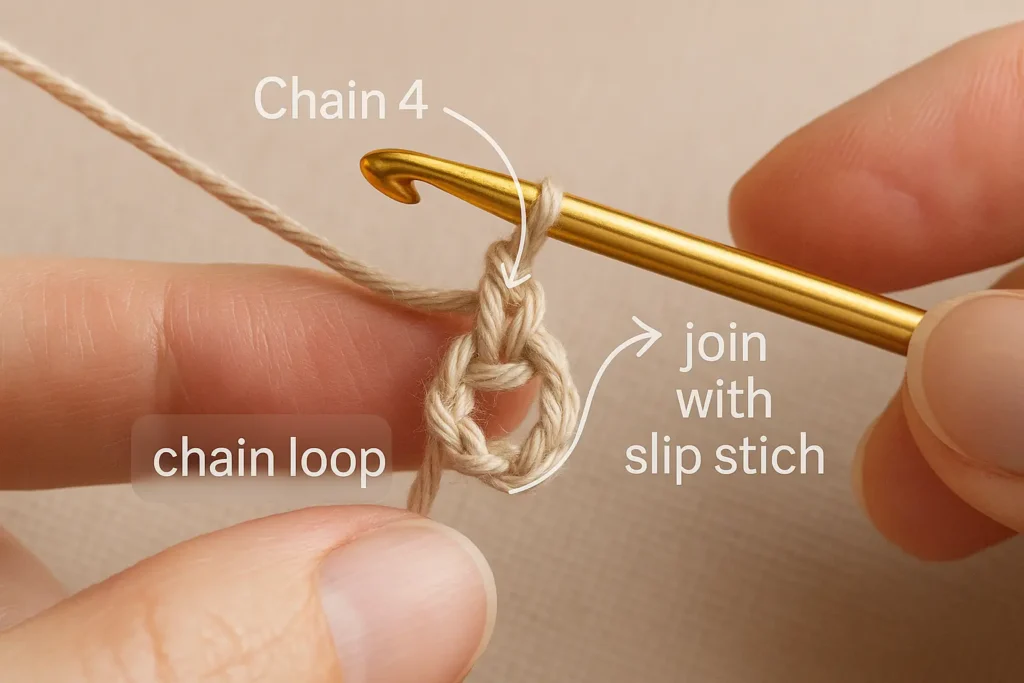
Why Some Crafters Still Prefer This Method
The chain circle may seem outdated, but it’s still a reliable technique. For some crocheters, it’s a go-to because it just feels more natural. Especially when you’re making flat pieces, the chain circle can be a quicker way to start your work.
Let’s look at some valid reasons people still choose it:
- Easier to learn: Less coordination required compared to the magic ring.
- More visible: Stitches are clearer, so beginners know exactly where to insert the hook.
- Good for non-stuffed items: For coasters, flat mandalas, or granny squares, it works beautifully.
However, the biggest weakness in the magic ring vs chain circle debate becomes clear with stuffed amigurumi toys: the center hole.
Even when pulled tight, a chain circle usually leaves a visible gap. That small opening might not bother you on a potholder, but if you’re making a plush animal for a child, it can be a problem. Fiberfill tends to peek through, and over time, the center may loosen further. That’s when most crocheters switch to the magic ring, it simply creates a more secure base.
From personal experience, I’ve used the chain circle when I just couldn’t get the magic ring right (especially with slippery yarns). It worked fine, but I noticed that pieces started to warp slightly after washing or handling.
So when comparing magic ring vs chain circle, it’s clear that one gives you a more professional finish, while the other offers simplicity. If you’re practicing, testing stitch tension, or working on a quick beginner-friendly toy, the chain circle can still get the job done.
In the next section, we’ll line up the magic ring vs chain circle in a real comparison: visual results, stitch behavior, and how they affect your finished amigurumi.
Comparison, FAQs & Final Verdict
Magic Ring vs Chain Circle : Side-by-Side Comparison
Now that we’ve explored both starting methods, it’s time to compare them head-to-head. Below is a quick overview of the magic ring vs chain circle to help you decide what fits best for your next amigurumi creation.
| Feature | Magic Ring | Chain Circle |
|---|---|---|
| Center Tightness | Fully adjustable, closes completely | Leaves a small hole |
| Beginner Friendliness | Requires practice and control | Easier to see and handle |
| Stitch Neatness | Seamless transition, pro finish | May cause slight distortion |
| Best For | Amigurumi, plush toys, closed shapes | Flat circles, granny rounds, testing |
| Used in Modern Patterns | Most amigurumi patterns use this | Rare in modern toy patterns |
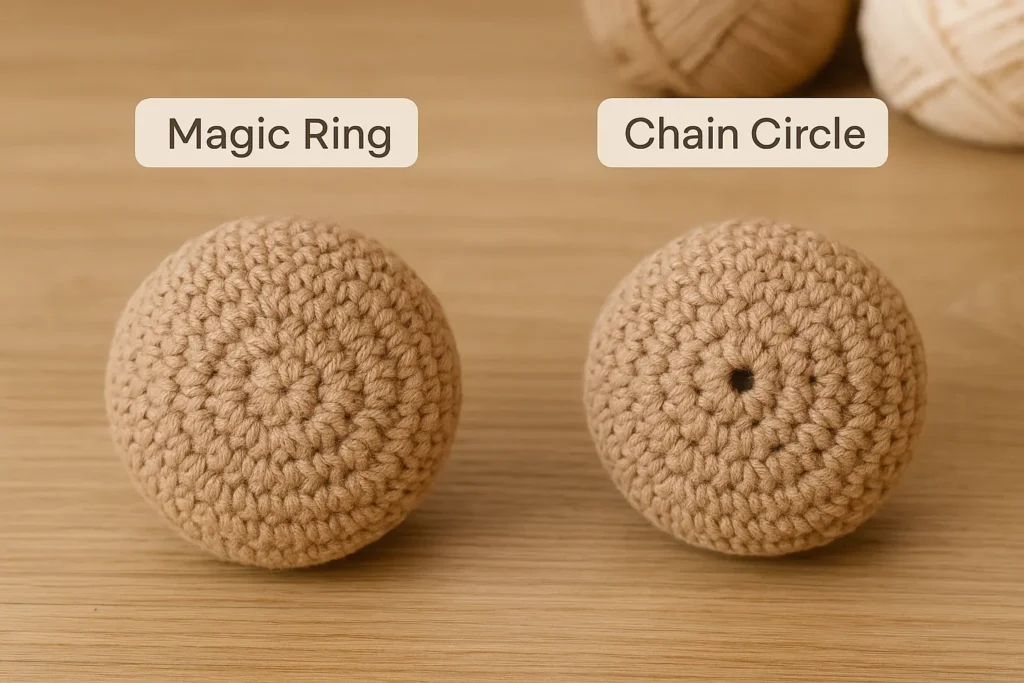
While both can work, the magic ring is preferred in nearly every stuffed amigurumi project. If you want a polished look, no holes, and a firm shape, it’s usually the winner in the magic ring vs chain circle showdown.
FAQs About Magic Ring vs Chain Circle
1. What is the difference between a magic ring and a chain circle in crochet?
The key difference in the magic ring vs chain circle comparison is how tightly the center closes. A magic ring cinches shut completely, leaving no hole. A chain circle is formed from a few chain stitches joined into a loop, which often leaves a small gap in the center.
2. Is a magic ring better for amigurumi than a chain circle?
Yes. For stuffed toys like amigurumi, the magic ring is usually preferred because it creates a tight, clean center. In the magic ring vs chain circle decision, most crocheters choose the magic ring for its polished look and durability.
3. Why does my magic ring loosen or fall apart?
A magic ring might loosen if the tail isn’t pulled tight enough or if the stitches in the first round are too loose. Be sure to pull the tail firmly after completing the first round, and weave it in securely to prevent unraveling.
4. Can I substitute a chain circle for a magic ring in any pattern?
Technically, yes—you can swap them in most patterns. But keep in mind that the chain circle doesn’t close as tightly. For decorative pieces or flat projects, it works well. For stuffed animals, the magic ring vs chain circle swap may affect the shape and finish.
5. Are magic circle and magic ring the same?
Yes! The terms “magic circle” and “magic ring” are used interchangeably in crochet patterns. Both refer to the same adjustable loop technique used to start crocheting in the round.
6. What are the disadvantages of magic rings?
While great for amigurumi, magic rings can be tricky to master. They require good tension control, and if not secured properly, they may loosen over time. Beginners may find them frustrating at first compared to a chain circle.
7. Is there an alternative to a magic ring?
Absolutely. The most common alternative is the chain circle, which is easier for beginners to control. While it may leave a hole, it’s still useful for flat projects or quick practice rounds.
8. What is the purpose of a magic ring in crochet?
The purpose of a magic ring is to start crochet in the round with a closed center. This helps prevent gaps in the fabric, especially important in amigurumi, where holes can let stuffing show through.
Want more tips like these? Don’t miss our article on how to read amigurumi patterns to build your reading skills fast.
Final Verdict: Magic Ring vs Chain Circle
So, what’s the best way to start your project?
For amigurumi, the winner is clear: the magic ring. It gives you:
- A seamless center
- Better shaping
- A strong start that holds stuffing perfectly
That said, if you’re still learning and the magic ring feels too tricky, start with a chain circle. Use it to practice stitch counts, gauge, and pattern reading. Over time, you’ll build the confidence to master both.
In the end, the magic ring vs chain circle choice is less about right or wrong, and more about what feels right for you at your stage of crocheting.
Want to see the difference for yourself?
Pick any free beginner amigurumi pattern and make two versions, one with a magic ring and one with a chain circle. Compare the texture, center, and how it holds shape. It’s a fun experiment and a great way to practice both!
For more tutorials, stories, and patterns, don’t forget to check out my crochet reflections on Medium—I share little wins, lessons, and freebie links just for readers like you.
And if you’re proud of your plushie, tag @TopAmigurumi on social media—I’d love to see what you create!

